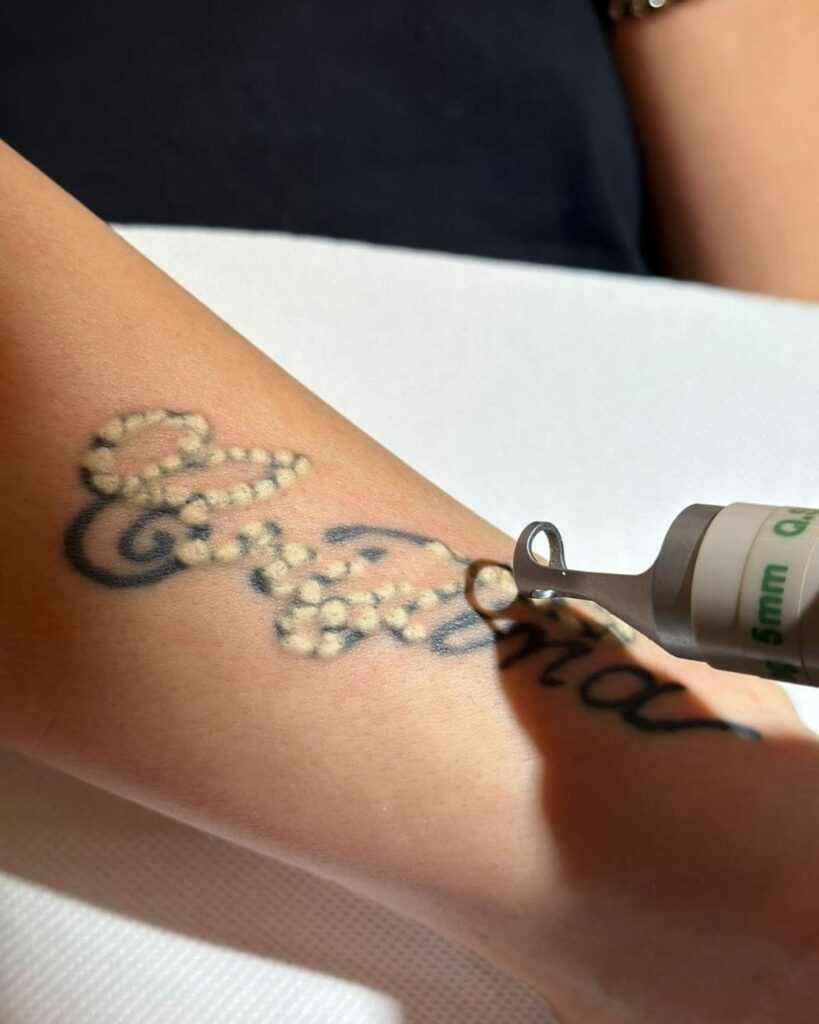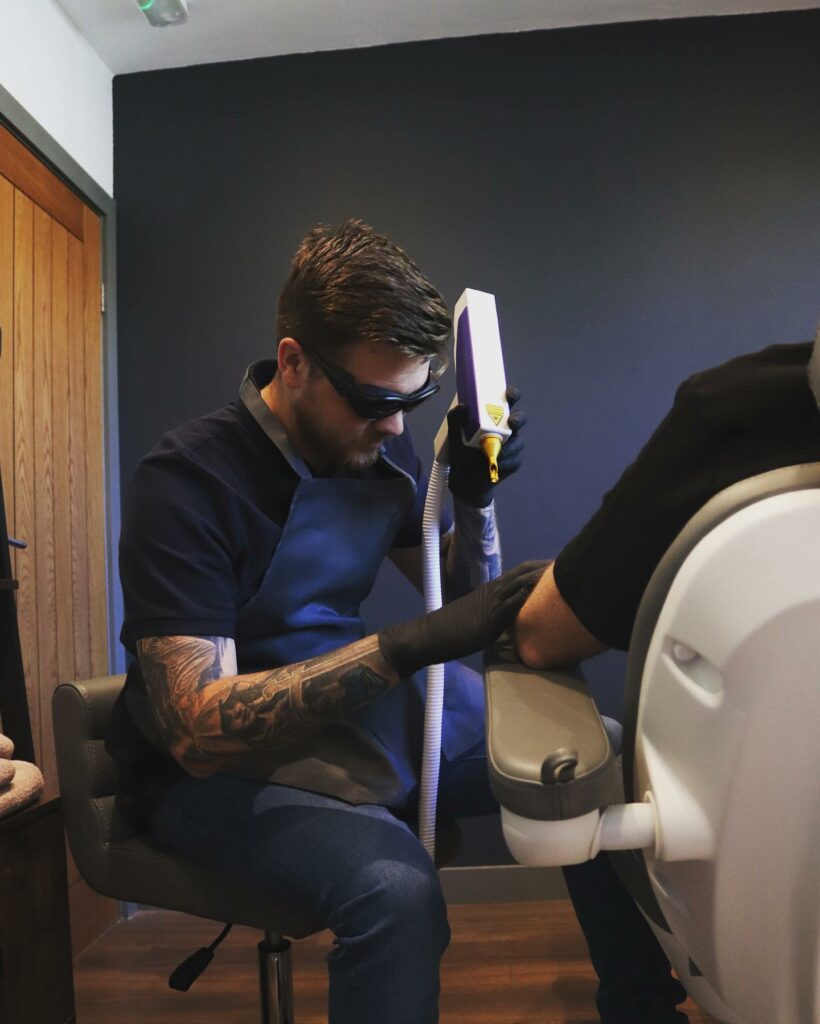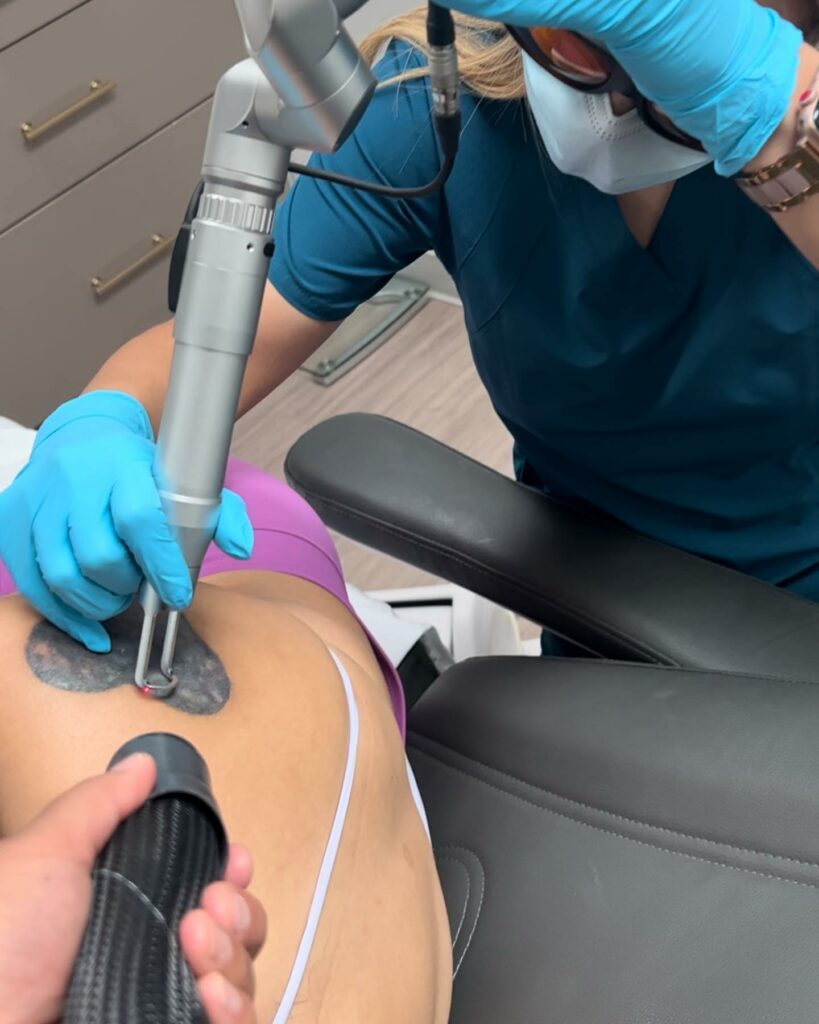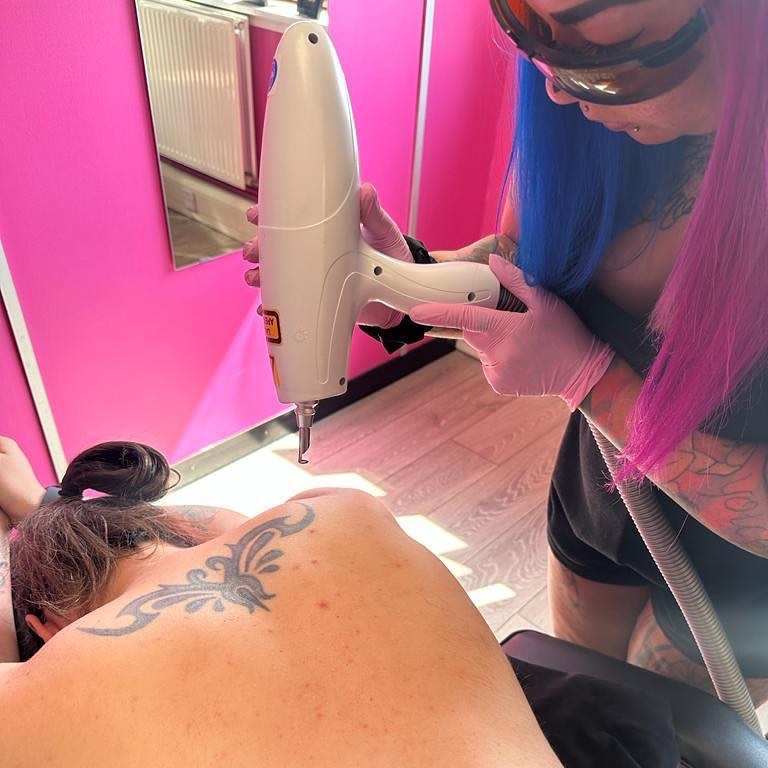Table of Contents
Our topic today: Saline Tattoo Removal versus Laser Tattoo Removal. I can almost see the questions swirling in your mind: “Saline? Isn’t that what I clean my contact lenses with?” or “Laser removal? That sounds like something out of a science fiction movie!” Well, strip away the jargon, and we have two potent and popular methods of tattoo removal that are fascinating in their own right.

In this blog, we will delve into the pros, the cons, the nitty-gritty details, and everything in between. We’ll explore the science behind these two processes, weigh their efficacy, and decipher which method might be the best fit for you. Buckle in – oops, my apologies. Just prepare yourself for a wild and informative ride, full of valuable insights, from the mechanics of tattoo removal to understanding the crucial aftercare.
So, whether you’re simply an information hoarder, toying with the idea of tattoo removal, or are on the precipice of booking that first removal session, stay tuned. By the end of this post, you’ll have the knowledge to make an informed decision about your path to a clean slate. Let’s debunk the myths, demystify the facts, and delve into the fascinating world of tattoo removal. Welcome aboard this journey from inked to pristine!
What Is Saline Tattoo Removal?

Think of a day at the beach, soaking up the sun, and diving into the salty ocean waves. Now, imagine that saline solution acting as a magic eraser for your tattoo. Sounds surreal, right? But that’s essentially what saline tattoo removal is, minus the ocean waves and sunburn.
In this process, we use a saline solution to coax the tattoo ink out of your skin. Though it’s not the quickest method for banishing your ink, it can be effective in certain situations. For instance, my friend Jade once had a tiny star tattoo on her wrist that she got in high school. Thanks to saline tattoo removal, it’s now a faded memory.
What Is Saline Solution?
Salt and water – the bread and butter of the saline solution for tattoo removal. But different brands might throw in a little something extra, like aloe vera, for added skin-soothing benefits.
What Is Saline Tattoo Removal Best Used For?
While I’d vote laser as the star player in tattoo removal, saline shines in some scenarios. It’s especially useful when dealing with cosmetic tattoos made from pigments that may not react well to lasers.

Traditional Tattoo Edits
In some cases, saline removal might be used for traditional tattoo edits, but I’d advise against it. Remember my buddy Mark who tried saline removal for his shoulder piece? The saline solution ended up spreading around a bit and unfortunately lightened areas he didn’t want to touch. For conventional tattoos, it’s just too tricky to control where the solution goes.
Eyebrow Tattoo Removal
As someone who has lived through the ’90s and experienced the ‘thin eyebrow’ trend, I’m grateful for saline removal. This method can help erase pigments used in brow tattoos effectively, especially when you’re not a fan of the shape or overall look.
How Does Saline Tattoo Removal Work?

The saline tattoo removal process has some similarities to tattooing and microblading. You’re essentially ‘tattooing’ the area with saline, which then works its charm through osmosis. It persuades the cells to release the ink or pigment. A scab forms, new cell growth begins below, and eventually, the scab (along with some of the pigment) falls off. The trick here is to allow enough healing time between sessions.
Saline Tattoo Removal vs. Laser Tattoo Removal
Now for the heavyweight match: saline versus laser. In my experience, saline can lighten a tattoo substantially over several sessions but doesn’t always result in complete removal.

On the other hand, top-tier laser technology can offer complete removal in most cases. Here’s a quick rundown of some key points to consider when deciding between these two:
- Recovery Time: You’ll need at least six weeks of recovery time between laser treatments. Saline removal needs a bit more, around 8 to 10 weeks.
- Aftercare: Both methods require careful aftercare to avoid complications. Saline tattoo removal creates an open wound, which carries more risk of infection and scarring.
- Comfort: Both methods are typically less uncomfortable than getting a tattoo, but healing can leave the area feeling a bit tender.
- Cost: Laser removal comes with a higher price tag due to its effectiveness. For example, eyebrow removal might cost $70-$100 with saline, but it can bump up to $150-$400 with laser.
- Ink Colors: Darker inks can be more stubborn with saline removal, but they’re often the easiest to banish with laser removal.
To summaries a different way,
Pros:
- Versatility: Saline removal is suitable for all ink colors and skin types, making it a versatile option.
- Safety: Since it uses a simple saline solution, there’s minimal risk of burning or other damage to the skin, unlike laser removal which can cause burns if not properly administered.
- Effectiveness on Cosmetic Tattoos: Saline removal works particularly well on cosmetic tattoos, such as eyebrow tattoos or other forms of permanent makeup, where the pigment may not respond well to laser treatment.
Cons:
- Potential for Scarring: The method creates an open wound on the skin, which carries the risk of scarring if not properly cared for during the healing process.
- Longer Healing Time: Healing between sessions can take up to 8-10 weeks, which is slightly longer than with laser removal.
- Partial Removal: Complete removal of the tattoo is often not achievable with saline removal, it usually results in substantial lightening of the tattoo instead.
Laser Tattoo Removal:
Pros:
- Efficiency: Laser removal tends to be faster and more efficient, often leading to complete removal of the tattoo.
- Precision: Lasers can be very precisely targeted, reducing the chance of damaging surrounding skin.
- Shorter Recovery Time: The recovery time between treatments is typically shorter, around six weeks.
Cons:
- Limited Effectiveness on Certain Colors: Some colors, especially lighter pigments and cosmetic tattoos, can be resistant to laser removal.
- Risk of Skin Damage: Lasers can cause burns, hyperpigmentation, or hypopigmentation, especially in people with darker skin tones. Proper administration is crucial to minimize these risks.
- Higher Cost: Laser tattoo removal can be more expensive than saline removal, due to the cost of the equipment and the expertise required.
Remember, every person and every tattoo is unique, and the effectiveness of these methods can vary. A consultation with a professional tattoo removal specialist is always the best first step to understand which method might work best for your specific tattoo and skin type.
How Effective Is Saline Tattoo Removal?

Generally, laser removal takes about 10 to 12 sessions on average. With saline, the number of sessions needed can be similar, but it’s much more unpredictable.
The effectiveness of saline tattoo removal can greatly vary depending on several factors, including the depth of the tattoo ink, the color of the ink, the size of the tattoo, and how your body responds to the treatment. It’s worth noting that while saline tattoo removal can be effective in fading or lightening tattoos, it often does not result in complete removal of the tattoo.
Darker colors and larger tattoos typically require more sessions for significant lightening. Additionally, tattoos that have been applied deeply into the skin may not respond as well to saline removal as they do to laser methods.
In the case of cosmetic tattoos, like those used for permanent makeup, saline solutions can sometimes be more effective as these pigments can react unpredictably with laser treatments. This makes saline tattoo removal a preferred option for removing or correcting cosmetic tattoos.
In conclusion, while saline tattoo removal can be effective for lightening tattoos and particularly useful for cosmetic tattoos, it may not always be the best choice if the goal is complete removal of the tattoo. It’s always best to have a consultation with a professional to understand the most effective method for your specific tattoo and personal goals.
Best Use Cases For Saline Tattoo Removal
Saline tattoo removal can be particularly beneficial in a few specific scenarios:
- Cosmetic Tattoos: Cosmetic tattoos, such as permanent makeup, often utilize pigments that may not react well to laser treatment. Sometimes, laser can alter the color of the cosmetic pigments instead of breaking them down, which can lead to undesired results. In these cases, saline tattoo removal can be a better option.
- Small Tattoos: Saline tattoo removal tends to be more effective with smaller tattoos compared to larger ones. This is because the process creates an open wound, which needs to be kept clean and protected. The healing process is generally easier and safer with smaller areas of treated skin.
- Surface Level Tattoos: If the tattoo ink has been deposited closer to the surface of the skin, saline removal might be more successful. For example, cosmetic tattoos are usually applied more superficially in the skin compared to regular tattoos, making saline removal a suitable option.
- Tattoo Fading: If your goal isn’t complete removal, but rather to lighten or fade the tattoo for a cover-up, saline tattoo removal can often be a good option. It can help prepare the area for a new design by reducing the visibility of the old tattoo.
However, it’s crucial to note that each person and tattoo is unique. It’s best to consult with a professional to determine the most effective removal technique for your specific scenario.
Risks and Side Effects of Saline Tattoo Removal
One of the significant pros of saline removal is its gentleness on various skin types – no hypo or hyperpigmentation. However, it does come with its own set of concerns. The most notable being the risk of scarring.

Also, since saline tattoo removal creates an open wound, there’s an increased risk of infection. So, keeping the area clean and adhering to aftercare instructions religiously is paramount.
Can I Do It At Home?
I cannot stress this enough: Do NOT attempt saline tattoo removal at home or any type of tattoo removal for that matter. DIY removal is a recipe for permanent skin damage and usually does little to actually remove the tattoo. Head over to social media and take a look at people’s before-and-after photos for their results.” Trust me, those pictures don’t lie!
What Is the Healing and Aftercare Process?
Post saline tattoo removal, your skin goes through several stages of healing:
- Day of treatment: The treated area might feel tender, almost like a mild burn, and appear red and swollen.
- First few days: Expect a scab to form over the treated area.
- One week later: The area should still be scabbed over.
- Two weeks later: The scab will likely have fallen off, but the skin may still appear pink or fragile as it continues to heal.
- One month later: Your skin should start looking more like its normal self.
- Two months later: The area should be completely healed and ready for the next session.

Following the aftercare guidelines provided by your removal specialist is critical in speeding up the recovery process. Standard guidelines for saline removal often include:
- Not covering the area (unless you work in an environment with a high risk of infection).
- Avoiding washing or picking at the area. Stay clear of lotions and soaps.
- Keeping the treated skin out of the sun.
- Refraining from activities that induce sweating and from immersing the area in water until the scab has completely fallen off.
- Letting the scab fall off naturally.
- Applying vitamin E oil as directed by your specialist after the scab falls off.
Conclusion
Alright, tattoo enthusiasts, that’s a wrap on our deep-dive into saline tattoo removal! Here’s the takeaway: the number of sessions for saline removal can be a bit of a guessing game, with factors like your removal goal and ink color playing a significant role. Be aware of the potential risks involved, such as scarring and infection, and make sure to stick strictly to aftercare guidelines to promote a safe and swift recovery. Remember, while we can DIY many things in life, tattoo removal is not one of them – always trust a professional with your skin! Most importantly, be patient with the process. Rome wasn’t built in a day, and tattoos don’t vanish in one either. Whether you’re leaning towards saline or laser, always make an informed decision that sits right with you. And when in doubt, book a consultation with a specialist who can guide you down the right path. Happy tattoo journeys to you all!




